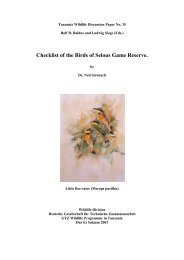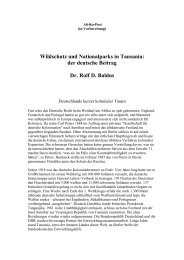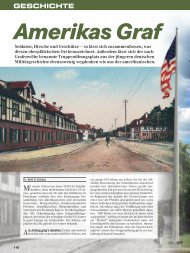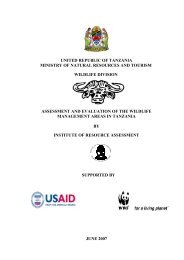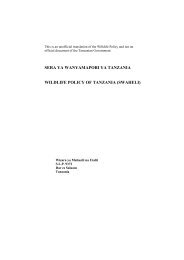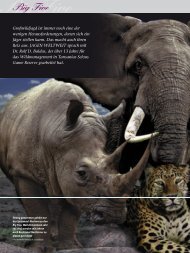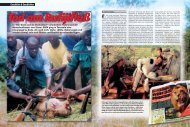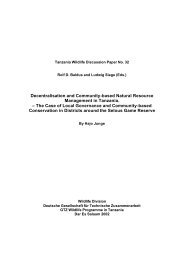African Indaba Articles - wildlife-baldus.com
African Indaba Articles - wildlife-baldus.com
African Indaba Articles - wildlife-baldus.com
You also want an ePaper? Increase the reach of your titles
YUMPU automatically turns print PDFs into web optimized ePapers that Google loves.
price and see very little effect”. One participant posted: “What I can't understand is why Tanzania doesn'thave an open auction process for concessions and allow foreign <strong>com</strong>panies to bid. With a 5 year lease anda rotating auction schedule so at least a few concessions <strong>com</strong>e up for auction every year Tanzania would getfair [market value]. With a fixed price of $50K some concessions may be under-priced while others may beover-priced. Tanzania will still lose revenue on under-priced concessions. Tanzania needs to fix its tenderprocess, until it does, they will continue to have problems.”To make matters worse, MNRT had officially applied to sell 100 tons of ivory ahead of the recentCITES CoP but withdrew just before a CITES inspection was due and after major irregularities of themanagement of the ivory stocks, including the sale of stamped tusks, became public knowledge. Due to badGovernance and the apparent involvement of the army and WD there is real danger that poaching for meatand ivory may again reach levels as in the 70s and 80s again .That would destroy <strong>wildlife</strong> including elephantsin large numbers.Part 2: A Review of Relevant PapersPossibly the most significant paper about hunting in Tanzania was published in July 2004, authored byDr. Rolf Baldus, at that time working for the Community Wildlife Management Program of the GermanGesellschaft fuer Technische Zusammenarbeit (GTZ) and by Andrew Cauldwell, who was with the EUfundedKagera Kigoma Game Reserves Project (EDF). Titled “Tourist Hunting and its Role inDevelopment of Wildlife Management Areas in Tanzania”, all three parts can be downloaded from the<strong>African</strong> <strong>Indaba</strong> website (see “references” at the end of this article for the relevant links).Fred Nelson from the Sand County Foundation Community Based Conservation Network, SimonMilledge of TRAFFIC East Africa, Dr Allan Rodgers, Regional Coordinator (Eastern Africa) UNDP–GEFBiodiversity Projects, the Tanzania Development Partners Group (DPG) and many others have alsodocumented the problems, risks and potential solutions for the <strong>wildlife</strong> sector in Tanzania for years (seereferences).The lack of an objective and transparent system for the allocation of hunting blocks has asconsequence that blocks are leased at administered prices far below the true market value irrespective ofsize, quality or in<strong>com</strong>e potential. This represents a large loss of in<strong>com</strong>e to Tanzania.The “official” <strong>com</strong>plaints about the “insignificant” contribution of trophy hunting to the Tanzanian GDPfail to see that the safari hunting revenue has to be viewed not in isolation, but in connection with relateditems like travel, hotels, payments to outfitters, taxidermy, freight forwarding, air charter, souvenirs, tips, etcas well as the taxes paid to the State. By using multiplier effects, the hunting industry’s contribution probablyhas been in excess of 130 million dollars in 2006.All authors basically arrive at the same findings and similar conclusions – and we list some in noparticular order: Despite the hunting sector’s impressive growth little information and data are available, andeven though a confidential report with empirical economic data was presented to WD in 2004there was no response; WD uses a control system based on favoritism leading to reduced in<strong>com</strong>e generation for thecountry, excludes rural <strong>com</strong>munities and resists efforts to introduce transparency and<strong>com</strong>petition, whilst attempts to discuss the issues in public are curbed; a tourist hunting policy and management plan to introduce <strong>com</strong>petition and to incorporate<strong>com</strong>munities as decision-makers was developed, signed and accepted by the Director ofWildlife in 1995, but has never been implemented. Legislative changes do not adequatelyreflect the proposals.; concessions are leased at rates far below market value, favoring the development of a systemof subletting to non-Tanzanian <strong>com</strong>panies and reducing the tax-base of the Government.Hunting revenue is based on a “Pay-as-Used”, rather than “Right-to-Use” system. This has notchanged despite political pressure to capture revenue potentials and real market value; calls for a transparent public tender process for hunting blocks with block fees chargedaccording to open market values went unheard;144



